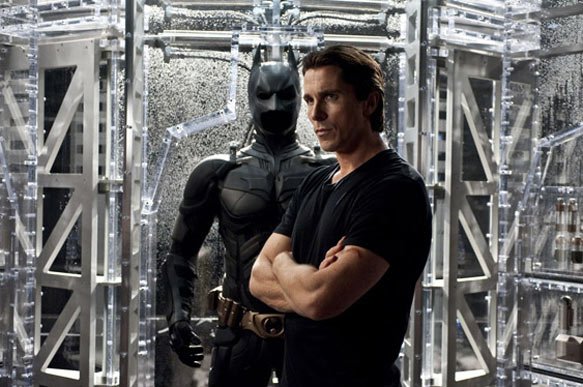The pivotal image in Nolan’s Dark Knight Rises isn’t the worn American flags or the exploding football field; rather, it’s an image that gained traction in viral marketing months ahead of the film’s premiere – the ‘strike zones’ of Bane, marked on a Gotham City map. This package, dispatched to crucial websites in December 2011, resurfaces in The Dark Knight Rises when Detective John Blake scrutinizes it for potential clues.
His reluctance surfaces, “I don’t possess knowledge about civil engineering,” he objects. Jim Gordon assures him, “But you understand patterns.”
The essence of The Dark Knight Rises, encompassing the entire Dark Knight Trilogy, revolves around patterns, networks, matrices, links, dialogues, and nodes on a map. It delves into the correlations among these terms and how they define themselves in relation to one another, capable of shifting and exchanging positions. The infiltration of a stock exchange by Bane’s men and Bruce contemplating the trades made is not merely a commentary on capitalism but a manifestation of these intricate patterns.
Much like Batman Begins implied that Scarecrow’s utilization of fear as a weapon mirrored Batman’s approach, and The Dark Knight heightened the stakes by questioning the distinction, if any, between Batman’s counter-terror tactics and Joker’s terror, The Dark Knight Rises explores the fragility of definitions and the boundaries of structures, challenging the illusion of binary oppositions.
The film underscores the significance of conditions at birth, upbringing, and social class – how characters are shaped and ascend in life. Simultaneously, it suggests the potential for liberation from these structures, allowing for individuals to break free, undergo transformation, and switch roles. Bane, hailing from a harrowing upbringing, ascends within the League of Shadows to assume a leadership role, only to be ultimately unveiled as a foot-soldier and Talia’s bodyguard. Bruce, born in the Regency room of Wayne Manor, finds himself confined by his privilege, loses his wealth, and experiences a fall (as declared by the headline ‘From Billionaire to Bum’). This downfall grants him the freedom to reinvent himself as a nomad, a no-man, akin to his transformation before donning the Batman persona in the initial film. The chant associated with Bane, echoing the scene from The Dark Knight where he rises into the sky as the plane falls, is replicated for Bruce as he takes a leap of faith from the prison pit.
John Blake ascends within the GCPD, progressing from a uniformed officer to a detective, shedding his uniform in the process. Addressing the guards on Gotham’s bridge, he asserts, “I’m a cop like you,” yet he acknowledges the significance of adaptability and fluidity. Shouting at his comrades blocking his path, he emphasizes, “The situation has changed. Your orders are out of date.” Blake comes to the realization that right and wrong are malleable concepts, not always aligning with the strict letter of the law. Disenchanted by the police’s insistence on rigid adherence to instructions, he discards his badge into the river and resigns from the force, conveying to Gordon that he has uncovered the tendency of structures to transform into shackles. Similar to Bruce and Miranda, he conceals his birth name behind a disguise but reclaims it, forging a new life in the film’s concluding scenes.
Haunted by her past, Selina Kyle resides in an Old Town walk-up, catching a glimpse of freedom when Bruce takes her airborne above the city’s highest points. Whispering in Bruce’s ear, she declares, “I’m adaptable,” and among the entire cast, she proves to be the most elusive. Introduced in disguise as a waitress, she back-flips from a window, discards her collar and cuffs, and metamorphoses into a socialite, mingling with guests at a charity ball. While she captivates Bruce’s attention, she also exhibits intimacy with her roommate Jen. Serving time in Blackgate prison as the sole woman among a multitude of men, she shares subtle coding as gender-queer, much like Miranda Tate, who volunteers in response to Gordon’s request for ‘men’ and is depicted in flashbacks as an androgynous child, initially mistaken for the young Bane.
The Dark Knight Rises skillfully manipulates language, utilizing the shifting meanings of words to resonate with its broader themes concerning characters as pawns on Gotham’s game-board, entangled in patterns of trade, exchange, and capture. Much like Joker’s desire to ‘watch the world burn,’ Bane becomes initially associated with the phrase ‘fire rises.’ However, it’s Batman’s signal that ultimately ascends as a burning emblem above Gotham, ignited by a flare in a reminiscent echo of the National Anthem’s ‘the rockets’ red glare,’ serving as evidence of his triumphant return.
In the street battles concluding the movie, Bane orders ‘open fire,’ seemingly disinterested in the games he set in motion. Talia assures Bruce that he will ‘feel the fire of twelve million souls,’ and as Bane is on the verge of executing his nemesis, he instructs him to ‘imagine the fire.’ However, this last word carries a dual meaning; Selina interprets it as a command, launching the Bat-pod’s missiles directly at him.
The film emphasizes that binary opposites are convenient constructs that seldom endure. In an early scene, we’re informed, ‘This is peacetime,’ yet by the conclusion, Batman has declared war. The narrative illustrates that orphans can evolve into cops or billionaires, while billionaires can descend into destitution. A police force can transform into a clandestine army, while Bane’s mercenaries rise to seize control of the streets. Tools have the potential to morph into weapons in the wrong hands – Wayne’s private armory literally cascades into Bane’s underground cave, and Miranda’s clean fuel supply undergoes a conversion into a neutron bomb. However, Batman finds himself pursued as a masked thug and murderer, with even Alfred noting, ‘you’ve got your taste for wanton destruction back.’
Bane, resembling a wrestler but speaking with the eloquence of a Shakespearean actor, embodies a stark contrast between refined performance and physical bulk. Selina effortlessly transitions from a hysterical victim to a composed operator within seconds. Bane places a gentle hand on a banker’s shoulder, accompanied by the murmured threat ‘Do you feel in charge?’ and, suddenly, the balance of power shifts. The CIA permits hostages onto a plane, yet within moments, the prisoners seize control. Explosions unveil the surface of a football field, laying bare the underlying structures of the city, exposing the industrial workings beneath the rituals of recreation. The Dark Knight Rises demonstrates that our assumptions can be upended, identity and history are fluid, and the pieces on the board can swiftly change places.
Even what appears to be death can serve as a form of rebirth and baptism through water – Gordon descends into the sewer to preserve his life, while Blake swings through a waterfall and emerges as a new Batman. Batman, in the ultimate sacrifice, ‘dies’ in Gotham Bay to grant Bruce Wayne his freedom. However, much like Miranda Tate, who changes her name and attains US citizenship but still inherits her father’s mission driven by familial duty, the film suggests that a clean slate – the ability to be ‘gone from every database on earth’ – might be a myth. Though Bruce seems to have exited the game safely, sipping coffee in Florence, both Alfred and Lucius are aware of his continued existence. Selina, seated across from him, still wears the Wayne family pearls, symbolically tethered to Bruce’s history even as she escapes her own. Complete detachment is impossible, and perhaps it’s not the solution.
The Dark Knight Rises is an integral part of a broader tapestry. It incorporates elements from The Dark Knight and Batman Begins, but the trilogy also nods to other movies such as Serpico, Metropolis, Blade Runner, and The Godfather, along with the vast matrix of Batman texts, including video games, comic books, and earlier films by different directors, like Burton’s installments of 1989 and 1992. The poignant scene of Batman’s sacrifice even appears as an affectionate nod to the 1966 Adam West movie: ‘some days you just can’t get rid of a bomb.’
As Nolan acknowledges, no reboot can entirely wipe the slate clean; instead, The Dark Knight Rises takes its position within the 73-year history of Batman, engaging in a dialogue with the past while shaping the character’s future stories. It is all the more enriched by its embrace of ambiguity and refusal to provide simplistic answers. To Nolan’s credit, his film contributes to a longer, ongoing conversation about the Dark Knight, rather than attempting to have the final word.
Also Read: 9 questions for Bahaa Abdelmegid


